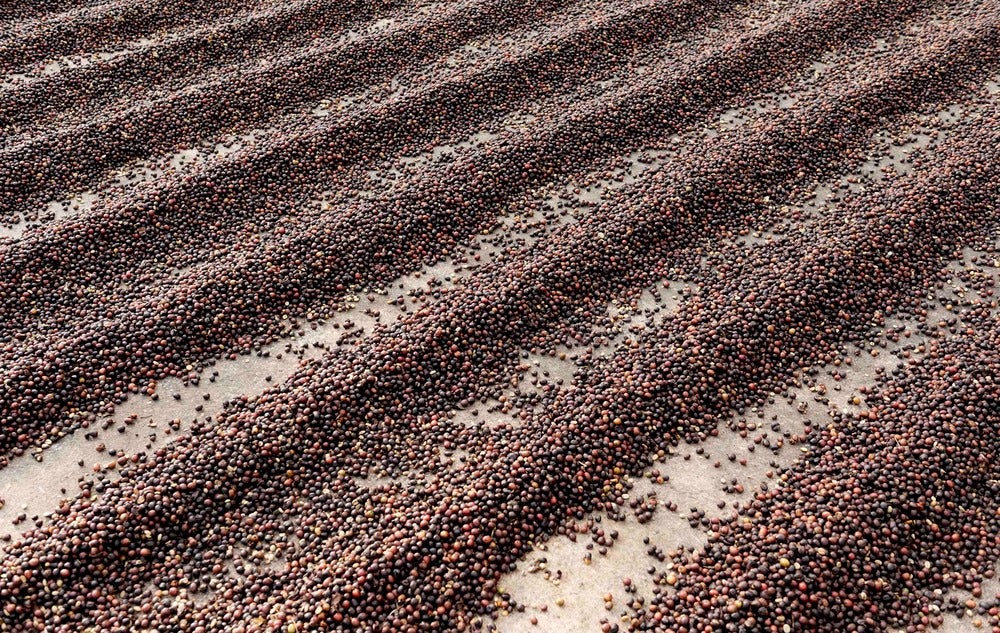About This Coffee
Hacienda Sonora sits at the foot of the Poas Volcano. The farm operates on 100% renewable energy generated by a hydroelectric generator that transforms rushing rivers into energy. The energy fuels the wet and dry mills and provides free electricity for everyone living and working on the farm. On the whole, Hacienda Sonora has shared its success generously, paying fair wages to all workers and bolstering the local community.
Cultivation
The farm and its mill cover approximately 100 hectares. Of those, 45 hectares are devote to shaded coffee lands. Coffee plants are surrounded by exotic trees and other native vegetation. This biodiversity promote soil health and maintains the nutrient-rich soil that helps grow dense, delicious cherry.
The remaining land has wild forest reserve growing on 35 hectares and 20 hectares for sugarcane, which has been grown on Hacienda Sonora’s land for over 150 years.
Harvest & Post-Harvest
Hacienda Sonora has its own micromill, which enables the farm to keep lots separated by variety and create unique microlots. The mill is centrally located, right next to a traditional sugarcane mill that’s been preserved intact for over 150 years.
This cascara comes from the Natural coffees processed at Hacienda Sonora. After selective handpicking, ripe cherry is washed in clean water and then laid to dry on either the farm’s raised beds or its patio where it is turned frequently to promote even drying. Once dry, Natural coffees are stored for 2 months before being hulled at the farm’s dry mill. The dried husks are removed and preserved as cascara.
Hacienda Sonora is a part of the NAMA Café de Costa Rica project, the first of the Costa Rican government’s Nationally Appropriate Mitigation Actions (NAMAs). They’re actively working towards lower carbon emissions through investments in key technologies and methods. NAMA Café de Costa Rica is the first of its kind to support coffee farmers as they make changes to their coffee production to reduce overall emissions and resource use. Hacienda Sonora has contributed carbon emissions data to NAMA Café de Costa Rica and will receive 10% back on carbon reduction investments.
Coffee in Costa Rica
Thanks to tireless innovations, the sheer number of coffee varieties, extensive technical knowledge and attention to coffee production, Costa Rica is one of the most advanced coffee producing countries in Central America.
The climatic conditions in the country also play a role in the high quality of coffee produced. There are eight coffee regions: Guanacaste, West Valley, Turrialba, Valle Central (Central Valley), Tres Rios, Brunca, Orosi, and Tarrazú, a specific part of Valle Central.
Costa Rica has also become a world leader in traceability and sustainability in coffee production. Ninety percent of the country’s 50,000 coffee farmers are smallholders, and today, many deliver their cherry to boutique micro-mills that often process cherries according to producer specs to retain single-lot or single-farm qualities.
The rise of micro-mill processing, in itself, is a relatively recent development. Prior to the early 2000s it was common for smaller producers to deliver their cherry to cooperative-owned mills. As lucrative specialty markets developed, more and more farmers began establishing mills on their own farms, giving them increased control over processing and more assurance of the ‘traceability story’ so important to the growing market segment. Mills with excess capacity would then offer their services to neighboring farmers, offering a range of processing methods for small lots along with full traceability for roasters and importers. The system has enabled Costa Rica’s small to mid-sized coffee farmers to offer a wide range of differentiated products. Today, specialty lots from Costa Rica are almost as likely to bear the name of the micro-mill where they were processed as that of the producing farm.
The typically uncertain and dry weather patterns in Costa Rica make coffee farming more difficult. Long dry seasons and unpredictable weather patterns have virtually eliminated the possibility of organic farming. Nonetheless, both the government and farmers have taken active steps to protect the environment. Some of these restrictions also inform the processing methods for which Costa Rican coffee has become known.

